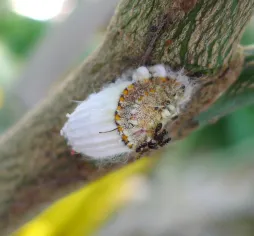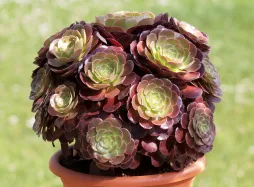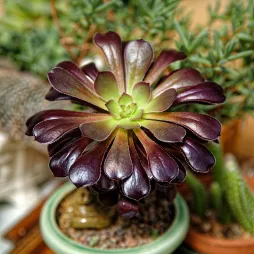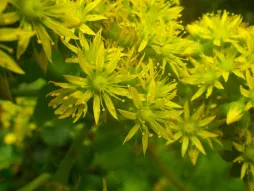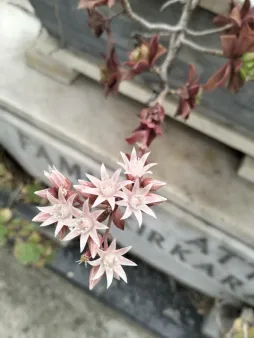Aeonium arboreum, a succulent cabbage
With its flat, compact rosette of leaves, Aeonium arboreum looks like a cabbage. But it doesn't belong in the vegetable garden! This fat plant native to the Canary Islands belongs to the Crassulaceae family. It is grown in the garden or indoors for its decorative foliage.
How to recognize Aeonium arboreum?
Aeonium arboreum is a succulent shrub with an upright habit. It grows to between one and two meters in height.
The plant has thick, branched stems. They bear leaf scars caused by the fall of older leaves.
The leaf blades grow in rosettes at the tips of the branches. Each rosette is made up of around fifty interlocking leaves and measures ten to twenty centimetres in diameter. During the dormant period in summer, the foliage contracts to form a ball. This technique enables the plant to retain moisture and withstand several months of drought.
The oblong, fleshy leaf blades have ciliated margins. They measure between five and nine centimetres. Their color varies according to variety. The typical Aeonium arboreum has glaucous-green leaves. Aeonium atropurpureum aeonium 'Zwartkop' has almost black leaves.
Tree cabbage flowers in spring. Yellow or pale pink flowers bloom on a pyramidal flower stalk. After flowering, the rosette bearing the inflorescence dies. But its offshoots and the other rosettes ensure the plant's survival.
Aeonium arboreum is non-toxic. It is harmless to humans and animals.
Our maintenance tips
If you live in a frost-free region, you can plant your Aeonium arboreum in the ground, provided the soil remains dry.
Elsewhere, it's best to opt for a pot culture and bring your Aeonium arboreum into your conservatory or living room when temperatures drop. The good news is that it's in winter, when the plant is growing, that it reveals all its beauty!
Watering
When it's very hot, your plant needs to be watered accordingly, as it goes into vegetative mode to protect itself.
Water your Aeonium arboreum when the soil has dried deeply. Use water at room temperature to avoid damaging the roots. If you can, use rainwater or non-calcareous water.
Never leave water standing in the saucer or planter, as this will rot the roots.
Do not water during this period.
Spray
Your aeonium arboreum hates wet foliage. You must not mist the plant.
Repotting
Re-pot your Aeonium arboreum in a pierced pot. Line the bottom with pebbles or clay balls to improve drainage.
Aeonium arboreum appreciate well-drained soil. You can use a substrate for cacti and succulents, or mix garden soil with river sand.
Pour a little potting soil into the pot and plant your specimen. Don't hesitate to push in the stem a third of the way up. This way, the plant will be more stable and produce more roots. Fill with potting soil and press down to remove air bubbles.
Prune
To encourage the growth of your Aeonium arboreum, prune regularly.
Remove dried leaves.
Cut back flower stems when flowers have wilted. If you use a tool, make sure it's clean and sharp.
Plantation
Your Aeonium arboreum loves light and hates humidity. Plant it in the sun and in a place where water won't stagnate after a shower, such as an embankment or the top of a slope.
Dig a hole twice the size of the root ball. Place pebbles or clay balls at the bottom to improve drainage. Plant your Aeonium arboreum and fill in with garden soil. You can add sand to lighten the soil. Press down to remove air bubbles.
Cutting
Cutting is carried out during the strong growth phase, generally in spring and early summer.
Locate a stem with a rosette. Remove a five-to-eight-centimeter section using clean, sharp pruning shears.
Leave to dry for at least 48 hours in the open air, until a callus forms.
Prepare a perforated pot. Place clay balls or pebbles in the bottom for drainage. Then fill with a light substrate, such as potting soil for cacti and succulents. Use a pencil or pick to make a hole.
Plant your Aeonium arboreum. Bury the stem about a third of the way up. This way, your plant will form more roots and be more stable. But don't bury the leaves! Place your cutting in a bright room with a temperature of between 15 and 18°.
Wait a few weeks before watering, to allow the roots to form.
Disease / Threat
Information
| Family | Crassulaceae - Crassulaceae |
| Type | Aeonium - Aeonium |
| Species | Aeonium arboreum - Aeonium arboreum |
| Lifecycle | Perennial |
| Foliage | Evergreen |
| Exposures | |
| Substrats | |
| Planting methods |
Open ground In pots In tubs |
| Categories | |
| Tag |
Beginner |
| Origin |
Southern Europe |
| Hardiness (USDA) | 9b |
| Leaf color |
|
| Flower colors |
|
Discover plants from the same family












